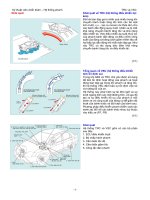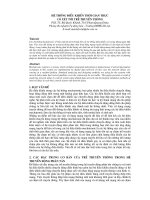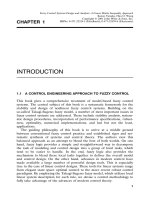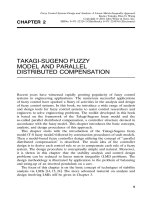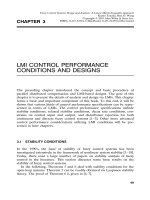Tài liệu Hệ thống điều khiển mờ - Thiết kế và phân tích P11 pptx
Bạn đang xem bản rút gọn của tài liệu. Xem và tải ngay bản đầy đủ của tài liệu tại đây (200.88 KB, 12 trang )
Fuzzy Control Systems Design and Analysis: A Linear Matrix Inequality Approach
Kazuo Tanaka, Hua O. Wang
Copyright ᮊ 2001 John Wiley & Sons, Inc.
Ž. Ž .
ISBNs: 0-471-32324-1 Hardback ; 0-471-22459-6 Electronic
CHAPTER 11
NONLINEAR MODEL
FOLLOWING CONTROL
In Chapter 9, the model following control for chaotic systems based on the
Takagi-Sugeno fuzzy models with the common B matrix is discussed. In this
wx
chapter, we present a more general framework 1, 2 to address the nonlinear
model following control problem for the fuzzy descriptor systems introduced
in Chapter 10. Specifically, these extended results deal with nonlinear model
following control for fuzzy descriptor systems with different B matrices. A
new parallel distributed compensation, the so-called twin parallel distributed
Ž.
compensation TPDC , is proposed to solve the nonlinear model following
control. The TPDC fuzzy controller mirrors the structures of the fuzzy
descriptor systems which represent a nonlinear plant and a nonlinear refer-
ence model. A design procedure based on the TPDC is presented. As in the
usual spirit of this book, all design conditions are rendered in terms of LMIs.
The proposed method represents a unified approach to nonlinear model
following control. It contains the regulation and servo control problems as
special cases. Several design examples are included to show the utility of the
nonlinear model following control.
11.1 INTRODUCTION
This chapter presents a unified approach to nonlinear model following
control that is much more difficult than the regulation problem. In this
chapter, the nonlinear model following control means nonlinear control to
reduce the error between the states of a nonlinear system and those of a
Ž. Ž. Ž.
nonlinear reference model, that is, lim x t y x t s 0, where x t and
t ™ ϱ R
217
NONLINEAR MODEL FOLLOWING CONTROL
218
Ž.
x t denote the states of the nonlinear system and those of the nonlinear
R
Ž.
reference model, respectively. The important feature is that x t is not
R
necessarily zero or a constant. The nonlinear system and the nonlinear
reference model are allowed to be linear, nonlinear, or even chaotic if the
nonlinear models are represented in the form of the fuzzy descriptor systems.
Thus, to execute the nonlinear model following control, we need the fuzzy
descriptor systems for a nonlinear system and a nonlinear reference model.
Now the question that needs to be addressed is ‘‘Is it possible to approximate
any smooth nonlinear systems with the Takagi-Sugeno fuzzy model having no
consequent constant terms.’’ The answer is yes in the C
0
or C
1
context. As
wx wx
mentioned in Chapter 2, it was proven in 3 and 4 that any smooth
nonlinear systems plus their first-order derived systems can be approximated
Ž.
using the Takagi-Sugeno fuzzy model having no consequent constant terms
Ž.
with any desired accuracy for more details, see Chapter 14 . Thus, the
nonlinear model following control discussed here is a unified approach
containing the regulation and servo control problems as special cases, where
‘‘servo control’’ means control for step inputs of reference signals.
As mentioned in Chapters 1 and 10, h l® / or denotes all the pairs
ik
Ž . ŽŽ.. ŽŽ.. Ž.
i, k excepting h z t ® z t s 0 for all z t ; h l h l® / or denotes all
ik ijk
Ž . Ž Ž .. Ž Ž .. Ž Ž .. Ž .
the pairs i, j, k excepting h z thz t ® z t s 0 for all z t ; and i - j
ijk
ŽŽ.. ŽŽ.. ŽŽ..
s.t h l h l® / or denotes all i - j excepting h z thz t ® z t s 0,
ijk i j k
Ž.
᭙z t .
11.2 DESIGN CONCEPT
In the nonlinear model following control, we use the fuzzy descriptor system
model introduced in Chapter 10 to describe both the plant and the reference
Ž.
system. The plant is represented by the fuzzy descriptor system 10.1 . To
Ž. Ž.
facilitate the analysis, system 10.1 is rewritten as 10.2 . In the following, we
develop the fuzzy descriptor system model for the reference system.
11.2.1 Reference Fuzzy Descriptor System
Consider a nonlinear reference model described via a descriptor fuzzy
system:
r
e
r
RR
® z t Ex t s h z t Dx t ,11.1
Ž. Ž. Ž. Ž. Ž .
Ž. Ž.
˙
ÝÝ
RR RR RR pR
l
l
p
l
l
p
s1
l
l
s
1
Ž.
n
R
n
R
=n
R
where x t g R and D g R ,
Rp
r
e
R
® z t G 0, ® z t s 1,
Ž. Ž.
Ž. Ž.
Ý
RR RR
l
l
l
l
l
l
r
R
h z t G 0, h z t s 1.
Ž. Ž.
Ž. Ž.
Ý
RR RR
pp
p
s1
DESIGN CONCEPT
219
Ž.
We use z t to denote the vector containing all the individual elements
R
Ž.Ž .
ztjs 1,2,..., p .
Rj R
Ž. w
T
Ž.
T
Ž.x
T
The augmented system with the new state x* t s x t x t is
˙
RRR
described as
rr
e
RR
UU
E*x* t s h z t ® z t Dx t ,11.2
Ž. Ž. Ž. Ž. Ž .
Ž.Ž.
˙
ÝÝ
RRRRRp
l
l
R
p
l
l
p
s1
l
l
s
1
where
I 00I
U
E* s , D s .
p
l
l
00 D yE
pR
l
l
11.2.2 Twin-Parallel Distributed Compensations
This section introduces the so-called twin parallel distributed compensation
Ž.
TPDC to realize nonlinear model following control. The main difference
for the ordinary PDC controller presented in Chapter 2 is to add a control
Ž.
term feeding back the signal of x t . It might be reminded that a similar
R
controller structure as TPDC was first employed in Chapter 9 in the nonlin-
ear model following control for chaotic systems.
Specifically, the TPDC fuzzy controller consists of two subcontrollers:
rr
e
UU
u t sy h z t ® z t Fx t , subcontroller A
Ž. Ž. Ž. Ž.
Ž.Ž.
ÝÝ
Aikik
i
s1 ks1
rr
e
RR
UU
u t s h z t ® z t Kx t , subcontroller B
Ž. Ž. Ž. Ž.
Ž.Ž.
ÝÝ
BRRRRp
l
l
R
p
l
l
p
s1
l
l
s
1
where
UU
wx
F s F 0 , K s K 0 .
ik ik p
l
l
p
l
l
Ž. Ž .
Note that u t is the same as 10.8 . The TPDC controller is obtained as
A
u t s u t q u t
Ž. Ž. Ž.
AB
rr
e
UU
sy h z t ® z t Fx t
Ž. Ž. Ž.
Ž.Ž.
ÝÝ
ik ik
i
s1 ks1
rr
e
RR
UU
q h z t ® z t Kx t .11.3
Ž. Ž. Ž. Ž .
Ž.Ž.
ÝÝ
RR RR p
l
l
R
p
l
l
p
s1
l
l
s
1
NONLINEAR MODEL FOLLOWING CONTROL
220
Ž.Ž. Ž.
The error system consisting of 10.2 , 11.2 , and 11.3 is as follows:
rr
e
UUUU
2
E*e t s h z t ® z t A y BF x t
Ž. Ž. Ž.Ž . Ž.
Ž.Ž.
˙
ÝÝ
ik ikiik
i
s1 ks1
rr
e
q 2 h z thz t ® z t
Ž. Ž. Ž.
Ž.Ž.Ž.
ÝÝÝ
ijk
i
s1 i-jks1
A
U
y B
U
F
U
q A
U
y B
U
F
U
ik i jk jk j ik
U
= x t
Ž.
ž/
2
rr
e
r
RR
y h z th z t ® z t
Ž. Ž. Ž.
Ž.
Ž.Ž.
ÝÝÝ
iRRRR
p
l
l
i
s1 ps1
l
l
s
1
= D
U
y B
U
K
U
x* t ,11.4
Ž. Ž .
Ž.
p
l
l
ip
l
l
R
Ž.
U
Ž.
U
Ž.
where e t s x t y x t .
R
Ž.
THEOREM 42 If conditions 11.6 hold, the error system becomes
E
U
e t s Gx
U
t y Gx
U
t s Ge t 11.5
Ä4
Ž. Ž. Ž. Ž. Ž .
˙
R
Ž.
by the TPDC fuzzy controller 11.3 ,
G s A
U
y B
U
F
U
, h l® / or,
ik i ik i k
1
UUUUUU
s A y BF q A y BF ,
Ž.
ik i jk jk j ik
2
i - j F r s.t. h l h l® / or,
ijk
s D
U
y B
U
K
U
, h l h l® / or.11.6
Ž.
p
l
l
ip
l
l
iR R
p
l
l
Ž.
Proof. We naturally arrive at the conditions 11.6 to cancel the nonlinearity
Ž. Ž .
of the error system 11.4 . Q.E.D.
Note that G is not always a stable matrix. The TPDC fuzzy controller
Ž.
11.3 with the feedback gains F and K should be designed so as to
ik p
l
l
Ž. Ž.
guarantee the condition 11.6 and the stability of the error system 11.4 .
THEOREM 43 The feedback gains F and K can be determined by sol®ing
ik p
l
l
Ž.
the following eigen®alue problem EVP :
minimize

Y
, Z , M , N
ik
subject to

) 0,
DESIGN CONCEPT
221
Z 0
1
- I,
0 Z
1
T
YY
13
T
Z s Z ) 0, Y sG0,11.7
Ž.
11
YY
32
T
Ž.
yZ y Z q s y 1 Y )
33 1
- 0,
T
Ž. Ž.
Z q AZ y BM q EZq s y 1 Y yZE y EZq s y 1 Y
1
i 1 iik k331kk12
h l® / or,11.8
Ž.
ik
T
y2 Z y 2 Z y 2 Y )
331
2 Z q AZ y BM
- 0,
1 i 1 ijk
T
y2 ZE y 2 EZy 2Y
1 kk12
qAZ y BM q 2 EZ y 2Y
ž/
j 1 jik k33
i - j F r s.t. h l h l® / or,11.9
Ž.
ijk

I )))
0

I ))
) 0,
00

I )
AZ y BM y AZ q BM yEZ q EZ 0 I
11 1 11 i 1 iik 11 k 1
h l® / or, 11.10
Ž.
iyÄ14 k

I )))
0

I ))
00I )
) 0,
AZ y BM
i 1 iik
00I
1
y AZ y BM q AZ y BM
ž/
Ž.
i 1 ijk j1 jik
2
i - j F r s.t. h l h l® / or, 11.11
Ž.
ijk

I )))
0

I ))
) 0,
00I )
AZ y BM y DZ q BN yEZq EZ 0 I
i 1 iik p1 ip
l
l
k 1 R 1
l
l
h l® lh l® / or, 11.12
Ž.
ik R R
p
l
l
ŽŽ.. ŽŽ.. Ž.
where h l h / or denotes all the pairs excepting h z t ® z t / 0, ᭙ z t
iyÄ14 kik
for i s 2,3,...,r and k s 1,2,...,r
e
. The feedback gains are obtained as
F s MZ
y1
and K s NZ
y1
.
ik ik 1 p
l
l
p
l
l
1
